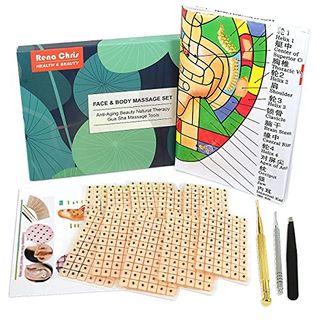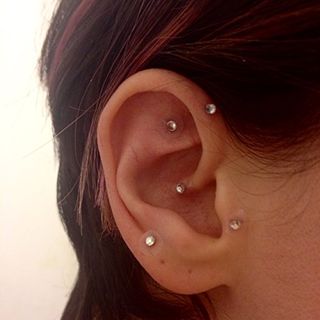They look great in a pair of earrings, but chances are, you don’t pay too much attention to your ears on a day-to-day basis. Yet social media influencers keeping up on the latest wellness trends have been seemingly obsessed with their ridged cartilage and lobes thanks to ear seeding, a modern take on acupressure that targets well-established acupuncture points within our ears.
In traditional Chinese medicine, the ear is considered a microsystem: A representation of the whole body. “The ear looks like an upside-down baby with the lobe being the head, the interior ridge being the spine, and the internal organs along with the recessed areas,” explains Tom Ingegno, a doctor of acupuncture and Chinese medicine based in Baltimore, Maryland.
That’s why, he explains, when pressure is applied to different spots of the ear in the ear seeding process, otherwise known as auriculotherapy, it can stimulate that point of the body. And when it does, it can help you in all sorts of ways by easing pain, lessening stress, easing allergies and more.
What are ear seeds — and what are they made of?
Ear seeds are, essentially, what they sound like: little seeds.
In traditional Chinese medicine, they are seeds of the Vaccaria plant, a type of seed that is roughly the size of poppy seeds. “This [vaccaria plant] herb is used for its blood moving properties and also reduces swelling, relieves pain and promotes healing,” says Sandra Subotich, a doctor of acupuncture and director of eastern medicine at Chicago-based Bian.
Today, ear seeds aren’t just seeds anymore. Some acupuncturists and stores sell some made of steel, silver, gold, crystal or magnets. Regardless of what they’re made of, the seeds are applied to different acupuncture spots of your ear using an adhesive or waterproof tape.
Once applied, you can wear the seeds all day — or up to three to five days tops, if the adhesive holds.
What are the benefits of ear seeds?
“Ear seeds are used to stimulate acupuncture points in the ear, by providing a constant stimulation,” Subotich explains. “Since the ear is a Microsystem of the entire body, ear seeds can be used to address a wide variety of issues.”
These issues, according to Subotich, include sleep problems, stress and anxiety, depression, headaches, addiction, weight management and holistic pain management. Research on substantiated benefits associated with ear seeding is limited, but many practitioners convey these potential benefits to those interested in exploring naturopathic treatment options.
Ear seeding has enjoyed a boom in popularity during the pandemic. “During these stressful times, ear seeding has included treating healthcare workers who are overworked and exhausted,” explains Barbara Gosse, an acupuncturist and educator with Northwestern Health Sciences University, because they may help ease insomnia side effects, and help individuals deal with stress and anxiety.
“Pressing on the seeds helps to more intensely stimulate the point and thereby stimulate the underlying nerves,” Subotich says. “This sends a stronger message through the neural pathways and helps to modulate the desired effect.”
This content is imported from Instagram. You may be able to find the same content in another format, or you may be able to find more information, at their web site.
In many ways, ear seeding is similar to acupuncture — but it doesn’t require any needles, which is an advantage to anyone that’s got a bit of trypanophobia. Ear seeds are also easier to administer, which means that once you know where to put them, you can apply them yourself.
Ear seeds also only apply pressure to your ear’s skin, which makes it minimally invasive — and now that the seeds are made of metals or even crystal, they can also be a bit of a fashion accessory because they look nice while you wear them. Ear seeds are also relatively low cost.
Is ear seeding effective?
According to those who practice traditional Chinese medicine, there are centuries of anecdotal evidence that it is effective for treating — or at least easing — the symptoms of many physical and psychological ailments. That’s why in 1957, Paul Nogier, a French physician, adopted the practice and published the ear map to help those in the west adopt the practice.
Unfortunately, though, there aren’t many large medical studies that have been published to back up the discussion of these benefits with direct correlation to ear seeds. Many smaller-scale studies, however, conducted independently have suggested that ear seeding may ease the pain on an individual basis.
A small 2013 study, for example, found that ear seeding could help reduce low back pain and improve mobility, while a 2015 study found the practice might increase pain tolerance. An older 2010 study shared in the Journal of Alternative Medicine also found ear seeding might relieve mild to moderate pain and a 2020 review of 14 other studies from Brazil found ear seeds could effectively reduce musco-skeletal pain. A 2021 study in the Journal of Personalized Medicine, meanwhile, found it could ease menstrual pain, causing people to need fewer pain medications.
Other studies have supported some of the other holistic health claims that ear seeding aficionados have floated in the past:
- A 2020 review of 24 studies found that in 22 of them, ear seeds could ease stress, anxiety and depression through survey results, while a 2017 study involving a clinical trial of 180 people found that ear seeding could reduce symptoms associated with body pain and anxiety.
- A BMC Complementary and Alternative Medicine review of other research also found that ear seeds could lessen the severity of insomnia symptoms, while a more recent 2021 review of nine clinical trials involving 688 people found that related ear therapy could improve sleep for cancer patients.
- Finally, a recent small study in the Journal of Integrative Medicine Research found that ear seeding helped with uterine recovery after a cesarean section.
Still, says Ingegno, ear seeding works best on “people who have moderate symptoms who are looking for simple relief and not expecting miracles.” In addition, many people also find that it benefits them most when it is practiced alongside regular traditional acupuncture sessions.
Are ear seeds safe?
The short answer? Yes! Ear seeds are generally considered safe to use as they are topically applied with little to no invasive materials used. There may be some application risks, however, that you should be aware of.
Some people are sensitive to the adhesive used to apply the seed (particularly if they have a latex allergy) or the metal of the seed itself, Gosse explains. This can cause some itching, discomfort or redness — all signs that you should remove the ear seed right away.
You’ll also want to avoid ear seeds if you have cracks, scratches or other injuries to your skin as the seeds could aggravate those injuries further.
In addition, Ingegno says, “you don’t want to leave them in place too long as you may develop a divot in the skin where the ear seed was placed.”
Ear seeds generally stay in place pretty well — but there is a small possibility they can fall off and fall into your ear canal, which could cause injury to your ear or lead to an infection. In 2015, the scientific community shared a record of what happened to a woman after the seed fell through a hole in her eardrum and had to be surgically removed.
The safest way to apply ear seeds:
You can buy ear seeds from an acupuncturist near you, which is recommended for ear seeding newcomers, as they often provide instruction — or any of the products available online.
“Consumer kits like the ones available from earseeds.com come with instructions, a chart of the relevant points and tweezers,” Ingegno says.
That said, all the acupuncturists we spoke with recommended talking with a professional before trying ear seeds for the first time by yourself.
“[If you] have your first treatment from a professional acupuncturist, they can help you decide which points are best for you,” says Laura Erlich, acupuncturist and women’s holistic health specialist with Mother Nurture Wellness in Los Angeles. They can also mark points in your ear with a skin-safe marker to make it easier for you to do at home.
Just make sure that while you’re applying them, you use a mirror and tweezers to apply the seed to your ear, while consulting a diagram of the acupuncture points in your ear. “Be aware that everyone’s ears have different shapes and that you might need to adjust placement based on the shape of your ear,” Ingegno explains. “Don’t expect your ear to look exactly like the picture in the product’s chart [and] don’t stress about getting them ‘perfect.’”
“Given the variation in everyone’s ears, finding the perfect location may seem impossible so aim for close enough,” he adds.
When it’s time to take them off, use a tweezer and tilt your head towards the ground so the seed doesn’t accidentally fall into your ear canal.
You might also want to give your ears short breaks between ear therapy treatments so that the skin doesn’t get aggravated over time. Some experts believe they stop being as effective when worn consistently. “Ideally you want to change your seeds out every 3 days, as the body will get used to the pressure,” says Subotich. “I generally will leave my seeds in for no more than 5-7 days and then give my ears a break for a day or two.”
This content is created and maintained by a third party, and imported onto this page to help users provide their email addresses. You may be able to find more information about this and similar content at piano.io




